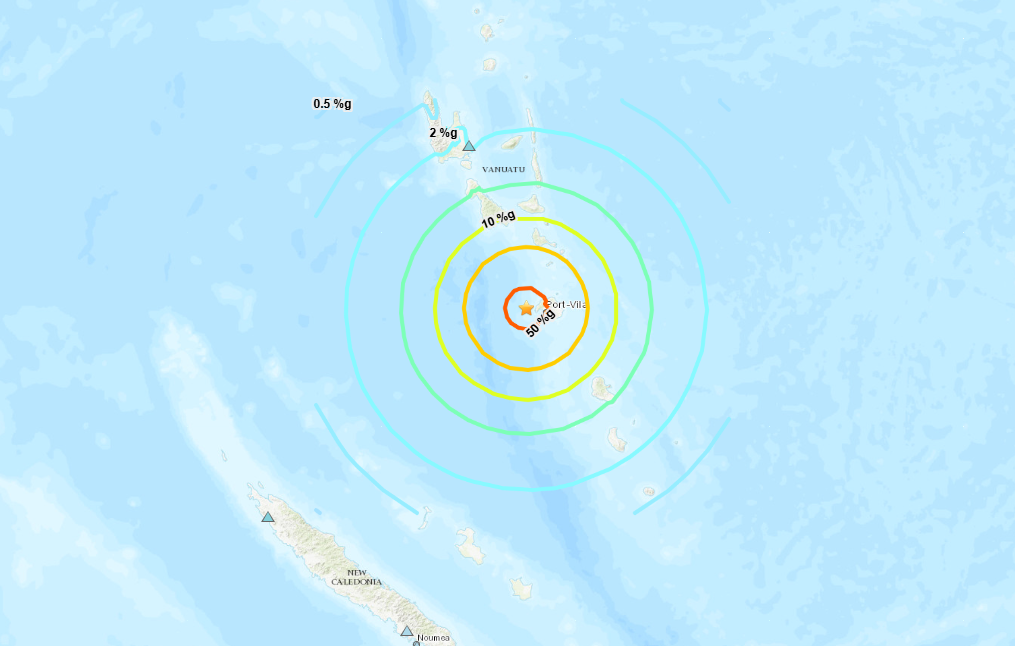A powerful 7.3 magnitude earthquake struck off the coast of Vanuatu, a South Pacific island nation, on Tuesday, December 17, 2024, triggering a tsunami warning that was later lifted. The quake’s epicenter was located just 18 miles west of Port Vila, the nation’s capital, at a depth of 35 miles. The impact was immediately felt across the archipelago, with a significant 5.5 magnitude aftershock following shortly after the initial tremor. Further tremors continued to rattle the islands throughout the afternoon and into the evening, leaving residents in a state of uncertainty and fear. While the tsunami threat receded, the true extent of the damage and potential casualties remained unclear in the immediate aftermath due to widespread communication outages. Phone lines, government websites, and other crucial communication channels were down, hindering efforts to assess the situation and coordinate relief efforts.
The earthquake struck a nation already vulnerable to natural disasters. Vanuatu comprises 80 islands and is home to approximately 330,000 people. Its geographical location along the volatile “Ring of Fire” makes it susceptible to both earthquakes and volcanic activity. The disruption to communication networks presented a significant challenge in assessing the immediate needs of the affected population. Early reports, emerging through intermittent phone calls and social media posts, painted a picture of widespread damage and potential casualties. Videos circulating online showed collapsed buildings, landslides, and debris-strewn streets in Port Vila. Crowds gathered outside Vila Central Hospital, suggesting a growing number of injured seeking medical attention.
Despite the communication challenges, fragmented information began to trickle out. A Red Cross spokesperson in neighboring Fiji reported significant damage in Port Vila based on communication with the head of the Vanuatu office before contact was lost. The New Zealand Foreign Ministry confirmed substantial damage to a building housing several diplomatic missions, including those of the United States, Britain, France, and New Zealand. Concerns rose for the safety of diplomatic staff, and the US Embassy promptly announced its closure until further notice. The extent of the damage to critical infrastructure, including the airport runway and the international shipping terminal in Port Vila, added to the mounting concerns about the nation’s ability to recover swiftly.
Eyewitness accounts provided glimpses into the chaos and devastation. Journalist Dan McGarry, reporting from Port Vila, witnessed the immediate aftermath firsthand. He reported seeing injured people being rushed to the hospital and described doctors working tirelessly at a makeshift triage center outside the emergency ward. McGarry highlighted the country’s limited capacity to handle a mass casualty event and pointed to the “massive landslide” at the international shipping terminal as a potential impediment to recovery efforts. While acknowledging the severity of the earthquake, the most significant he had witnessed in his 21 years in Vanuatu, he expressed a sense of relief that the situation “could have been worse.”
As the world watched with concern, international aid organizations and neighboring countries prepared to offer assistance. Katie Greenwood, head of the Asia-Pacific regional office for the Red Cross, expressed her apprehension about potential casualties given the density of buildings and hotels in downtown Port Vila. Australia’s Foreign Minister Penny Wong reassured Vanuatu that Australia stood ready to provide necessary support, emphasizing the close relationship between the two nations. New Zealand’s Foreign Minister Winston Peters expressed his government’s deep concern and confirmed efforts to account for the 45 New Zealanders registered as being in Vanuatu.
The earthquake served as a stark reminder of Vanuatu’s vulnerability to seismic activity. Situated on a subduction zone where the Indo-Australian Plate slides beneath the Pacific Plate, the archipelago frequently experiences earthquakes of magnitude 6 or greater. While building codes in Vanuatu generally incorporate seismic resilience, the true test lies in the ability of structures to withstand the intensity of such a powerful quake. The full extent of the damage and the number of casualties remained to be determined as communication channels were restored and assessment teams gained access to affected areas. The focus shifted towards immediate relief efforts, including providing medical assistance, securing shelter for those displaced, and restoring essential services. The long road to recovery for Vanuatu had just begun, requiring a concerted national and international effort to rebuild homes, infrastructure, and livelihoods.


